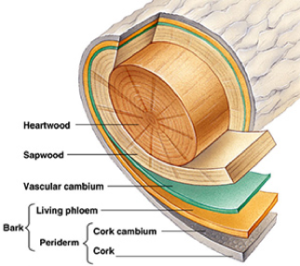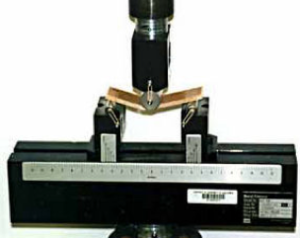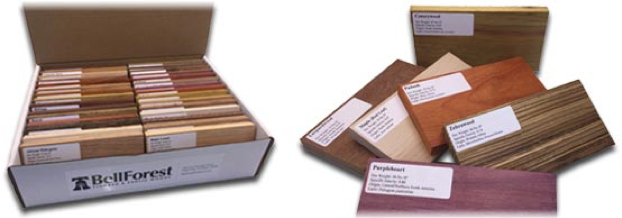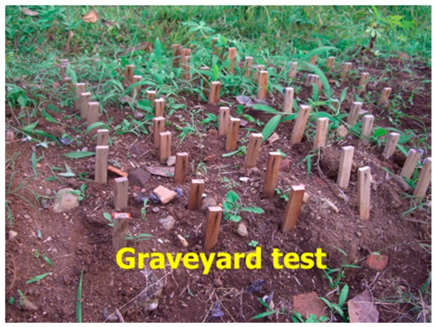Module 2: Values of Natural Forests: Harvested Products
Topic 2.1: Wood and Wood Products
Although “wood” is technically defined as secondary xylem and is the product of cell divisions in a secondary (=vascular or lateral) cambium, the term here will be used here more loosely to include the stems of palms and bamboo. Palms and bamboo lack a vascular cambium, but their “wood” is used in many of the same ways as the wood from other trees. The most valued products in many forests is wood, thus the extensive attention to its properties in this chapter. Wood varies a great deal in its working properties, market values, and end uses. Often the desired characteristics of wood influence silvicultural decisions and vice versa, hence their inclusion here.
The field of wood technology is old and extremely well developed; here we can only mention some of the major properties of wood and discuss how they are influenced by growing conditions in the forest. Among the basic characteristics of wood of interest to end users are density, various mechanical properties (e.g., strength and elasticity), durability, appearance, and number so-called “working properties” (e.g., the tendency to splinter when nailed).

Figure 2.1.1. Cross-section of a tree stem.
Material properties of wood vs. structural properties of trees
Throughout the discussions that follow, caution must be taken to not confuse material and structural properties. Although knowledge of wood properties can be used to generate predictions about tree resistance to mechanical damage and other structural features, the connections are by no means direct. For example, a tree that has a large diameter but short stem might be rigid and wind-resistant (structural properties) even if its wood is extremely weak (a material property). Nevertheless, forest managers will benefit from an understanding of the correlations between wood properties and tree properties as well as from knowledge about how both are influenced by growing conditions.
Wood density (g/cm3 or Mg/m3; also known as specific gravity) is in itself important but is also correlated with a number of other wood properties. Densities vary by about one order of magnitude, from 0.15 g/cm3 in Ochroma pyramidale (balsa; Bombacaceae) to 1.25 g/cm3 in Guaiacum sanctum (lignum vitae; Zygophyllaceae; see Table 2.1 for the properties of some common timbers). Tree species that are characteristically slow growing often have denser wood than typically fast growing species. Wood density also varies within a species with growing conditions and with location within a tree. Stressed and slow growing trees generally have higher density wood than fast-growing conspecifics. As wood ages, it also tends to increase in density; the highest density wood in a tree is thus typically in the heartwood of the butt log whereas the lowest density wood is in the sapwood of branches. Wood density is generally positively correlated with strength, rigidity (the opposite of elasticity), and durability. Foresters should be cautious about this and the other general trends presented because there are many exceptions to all of them to place too much faith in predictions of wood and tree properties based on density alone.
Depending on the way wood is to be used, different densities are preferred. Fine cabinet and furniture woods are often extremely heavy, as are woods used for flooring and bed liners in trucks. For house construction, in contrast, woods of intermediate densities are usually preferred (0.4-0.6 g/cm3). For almost all uses, wood from trees that have experienced radical changes in growth rates can be a problem due to differential shrinking and swelling of the resultant layers of different density. The same problem applies to trees that have produced “reaction wood” to restore their bent stem to an upright position; reaction wood is denser than normal wood, and hence shrinks and swells comparatively little and often differently than the surrounding “normal” wood.
Mechanical properties of wood are measured using standard size samples of defect-free (=clear) wood tested under controlled laboratory conditions. Strength (expressed as the “modulus of rupture”) and flexibility (expressed as the inverse of the “modulus of elasticity”) are commonly measured in compression, tension, and torsion (=twisting). Considerations of sample shape and size are eliminated mathematically, and values are expressed on a per unit sectional area basis.

Figure 2.1.2. A device used to measure the flexibility and strength of wood samples. The downward force, which is applied very slowly, is measured as is the displacement.
Working properties and visual appearance of wood
There are a multitude of other standard wood tests that are used to determine how woods of different species can most appropriately be used. Carpenters might be concerned about how well a particular wood might hold a nail or how well the surface planes or reacts to different finishes. Cabinet-makers need to know how much a wood will shrink and swell with ambient moisture conditions. For injecting wood preservatives (e.g., copper chromium arsenate) in fence posts and etc., xylem vessel dimensions and the presence or absence of tyloses that occlude vessel pores are critical considerations.

Figure. 2.1.3. Collections of wood samples
Natural resistance to decay
Durability of wood exposed to rain, sun, and wood-decomposing organisms is generally described on the basis of what are called “graveyard” tests. Standard size samples of wood are set out on the ground, buried in the soil, or suspended above the ground (depending on the intended use) and the state of decomposition is described periodically. Often the results are described in terms of the proportion of samples still sound or utilizable after a given number of years of exposure to the “elements.” Although data on the decomposition rates of different wood samples are of some interest to forest managers, they are not all that closely correlated with the susceptibility of woods in living trees to decay. Many trees with woods that decompose rapidly in graveyard tests are quite resistant to decay while still inside living trees due to rapid responses of living xylem cells in sapwood (i.e., parenchyma) to mechanical damage or pathogen attack. These living cells produce defensive (=secondary) compounds that can rapidly isolate the damaged tissues in compartments of decay. Compartmentalization of decay is a topic that will receive attention later, when tree damage during logging is discussed.

Figure 2.1.4. A “graveyard” test for evaluating the rot resistance of wood samples from different species, provenances, or treatments (e.g., with preservatives).
Primary wood processing
Whether wood is to be sawn into lumber, peeled on a rotary lathe or sliced to make veneer, chipped and glued back together to make chipboard or particle-board, or pulped to make paper (to mention just a few processes and uses), characteristics of the raw material delivered to the mill are critical. Above all else, conversion efficiency (=the proportion of raw material that appears in the finished or semi-finished product), is of critical importance. Many of the benefits of silvicultural treatments to increase tree growth and controls on logging operations to reduce waste in the forest, are lost if milling is inefficient.
Many factors influence the proportion of a log delivered to a mill that ends up being used including what is being produced and the type of mill. Efficiency of conversion of logs (=roundwood) to sawn lumber varies among mills from less than 40% to greater than 70%. In “integrated” mills in which “offcuts” are used to make blockboard (used as the core in plywood) or moulding (=trim boards often made of small pieces of wood glued together), virtually the only wasted wood is the sawdust. The amount of sawdust varies with the kerf (=width) of the cutting blade. Kerfs of bandsaws (1-2 mm) are generally less than that of circular saws (2-3 cm), but if the bandsaw cuts are wavy and not straight due to poor saw “doctoring,” what is saved in the primary sawing is lost when the lumber is planed down to consistent dimensions. Due to the extremely wide kerfs of chainsaws (4-6 mm), loss of wood as sawdust is relatively great where logs are sawn into lumber using chainsaws either with or without ripping guides. In mills that use even sawdust as fuel to produce electricity in steam generators or for kiln-drying wood, the efficiency of conversion is particularly complicated to calculate given that consideration must be given to the various end uses of logs that enters the mill.
Others factors that influence wood conversion efficiency are log size and shape. The highest “recovery” in mills of all sort is from large logs that are straight, little tapered, and with no areas of rot, loose knots, or other defects. Due to reductions in conversion efficiency and increased cost of hauling per unit volume, small, crooked, and defect-containing logs that could nevertheless yield marketable products are often left in the forest for purely financial reasons. Some logging firms have increased their conversion efficiencies by using small sawmills set up near logging areas to process logs of a lower standard than those that are hauled all the way to ports or major mills. In this way, the logger does not have to pay for hauling the abundant offcuts from sub-standard logs. Where there is a market for firewood or charcoal, wood with defects and branch wood are sometimes harvested and sold.
Wood extractives
Resins naturally exuded by trees of some species in response to injury or insect attack are often extracted and marketed for use in paints and lacquers, and as components of a variety of products including perfume, cleaning agents, and soft drinks. Some wood resins are extracted from living trees by wounding them and then collecting the exudates (Figure 2.1. Dammar collection from a dipterocarp tree in Indonesia and resin-tapping from a pine tree in Mexico.). Industrial processes are also well developed for extracting resins from sawdust and wood wastes, and resin is necessarily removed from wood pulp during paper making.
Prices of wood products
Due to the characteristics of logs used for different products (e.g., veneer vs. chips), the various end uses of wood (e.g., furniture vs. oriented strand board), the range of labor costs of different wood processing methods, and differences in the costs of processing equipment, wood products vary a great deal in price. These prices fluctuate somewhat from year to year with supply and demand, as influenced by economic trends in importing and exporting countries. The prices given in Table 2.1 are simply indicative and certainly do not reflect prices that you are likely to encounter were you to try to purchase a container of saw timber or a ton of short-fiber pulp. Inaccurate as they might be, these prices might help in evaluating different forest management options (e.g., management of natural forest for high quality timber vs. conversion to pulpwood plantations).
